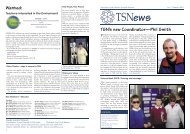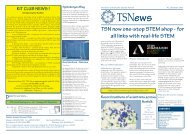Common Prawn – Palaemon serratus – 60mm/2.5''
Common Prawn – Palaemon serratus – 60mm/2.5''
Common Prawn – Palaemon serratus – 60mm/2.5''
You also want an ePaper? Increase the reach of your titles
YUMPU automatically turns print PDFs into web optimized ePapers that Google loves.
<strong>Common</strong> <strong>Prawn</strong> <strong>–</strong> <strong>Palaemon</strong> <strong>serratus</strong> <strong>–</strong> <strong>60mm</strong>/<strong>2.5''</strong><br />
Like crabs the <strong>Common</strong> <strong>Prawn</strong> has 10 legs <strong>–</strong> including those with claws on. They also have other<br />
appendages which are used for feeding, breathing and <strong>–</strong> as in many other crustaceans - swimming.
Bib or Pouting <strong>–</strong> Trisopterus luscus - 450mm/18''<br />
Bib are constant companions to divers around wrecks, their bold stripes tend to fade as they grow older.<br />
Although they are related to Cod they aren't often eaten as they don't taste very pleasant.
Peacock Fanworm <strong>–</strong> Sabella pavonina <strong>–</strong> upto 30cm/12''<br />
Even worms can be beautiful! Like many<br />
worms this one hides its body. It likes to live<br />
fixed to a hard surface and to protect itself it<br />
builds a tube since it doesn't burrow.<br />
The worm lives in the tube and feeds by<br />
extending a feathery fan of filaments to catch<br />
particles carried in the passing current. It<br />
retracts the fan to eat what it has caught and<br />
if it is startled.<br />
While they are usually very small (less than<br />
2.5cm/1'') in exposed positions they can grow<br />
to be much larger in sheltered places.
Velvet Swimming Crab <strong>–</strong> Necora puber <strong>–</strong> 100mm/4''<br />
Velvet Swimming Crabs are feisty scavengers who fearlessly threaten divers and rarely use their paddle<br />
shaped back legs to swim away. It is the covering of short bristles that gives rise to the common name.
Lightbulb Sea Squirt <strong>–</strong> Clavelina lepadiformis <strong>–</strong> 25mm/1''<br />
These simple animals are remotely related to us, and other advanced animals, because when they are<br />
young they have a simple spinal cord. They grow in clusters and filter food from the passing seawater.
Facelina auriculata <strong>–</strong> a sea slug <strong>–</strong> 40mm/1.6''<br />
This dramatic animal is another of Norfolk's<br />
many types of sea slug. The photo shows an<br />
adult hunting on the wreck of the Rosalie at<br />
Weybourne for its favourite food <strong>–</strong> animals<br />
called hydroids which are rather like tiny<br />
jellyfish on stalks.<br />
Oaten Pipe Hydroids <strong>–</strong> Tubularia larynx<br />
These hydroids grow in Spring on wrecks<br />
and reefs. This attracts nudibranchs who<br />
feed on them and breed during the Summer,<br />
leaving just the stalks when they have<br />
finished grazing.
Hermit Crab <strong>–</strong> Pagarus bernhardus - 75mm/3''<br />
Hermit crabs are very common on the Norfolk seabed, there are more than 20 species living around the<br />
UK. This is the only type to grow to more than 50mm <strong>–</strong> it also has one claw much larger than the other.
Long Spined Sea Scorpion <strong>–</strong> Taurulus bubalis - 30cm/12''<br />
Sea Scorpions are ambush predators and change colour to hide themselves. When a meal moves close<br />
they extend their large mouths in a split second to swallow it. Their spines protect them from bigger fish.
Elegant Anemone <strong>–</strong> Sargatia elegans <strong>–</strong> 5cm/2''<br />
There are many types of anemone in the<br />
North Sea, all feed by trapping food with<br />
sticky, stinging tentacles. The Elegant<br />
Anemone can occur in many colours but we<br />
only usually see the more subtle shades in<br />
Norfolk.<br />
They expand their bodies with water to<br />
stretch out into the water column but shrink<br />
into almost nothing when they retract their<br />
arms to collect their food or are uncovered by<br />
the retreating tide.
Violet Sea Slug <strong>–</strong> Flabellina pedata <strong>–</strong> 20mm/0.75''<br />
This sea slug or nudibranch is common off Norfolk in the Summer. Nudibranchs often eat tiny stinging<br />
animals, related to corals, then they reuse those stinging cells for their own protection to deter predators.
Sea Gooseberry <strong>–</strong> Pleurobranchus pileus <strong>–</strong> 20mm/0.75''<br />
These beautiful animals are related to anemones, corals and jellyfish which feed by stinging their prey.<br />
They use sticky threads to fish for particles of food and swim by rippling lines of plates along their sides.
<strong>Common</strong> Lobster <strong>–</strong> Homarus gammarus - 90cm/36''<br />
Lobsters are the kings of the Norfolk coast,<br />
their only real threat is from man.<br />
They are intelligent and like to investigate<br />
divers. Unlike crabs, which move sideways<br />
and often run away, lobsters will advance to<br />
meet you. They sometimes enjoy having their<br />
antennae stroked but can retreat rapidly<br />
backwards by flipping their broad tails if they<br />
are startled and want to leave in a hurry.<br />
Although popular as seafood they can live as<br />
long as humans when left to their own<br />
devices. They are also gourmet diners<br />
themselves as their huge claws are different,<br />
one for cutting and one for crushing <strong>–</strong> built in<br />
cutlery!
Horse Mackerel <strong>–</strong> Trachurus trachurus - 50cm/20''<br />
Horse Mackerel are summer visitors to the East coast and spawn in the North Sea. They feed on smaller<br />
fish. Fish use their reflective bodies to confuse predators. They flash as they all change direction together.
Snake Pipefish <strong>–</strong> Entelurus aequoreus - 60cm/24''<br />
These strange yellow fish appeared in huge numbers in 2007, causing difficulties for Puffins in the North<br />
whose young could not digest them. They are related to seahorses which have similar hard, bony bodies.
Tompot Blenny <strong>–</strong> Parablennius gattorugine - 150mm/6''<br />
This fish is the star of many marine conservation campaigns as his friendly face is very loveable. It was<br />
believed there were none in the North Sea until they were reported by Seasearch off Weybourne in 2007.
Edible Crab <strong>–</strong> Cancer pagarus - 300mm/12''<br />
Famous as the 'Cromer crab' this powerful animal can grow to the size of a dinner plate and crack bone<br />
with its claws. They prefer to avoid confrontation and lock themselves into safe crevices with their elbows.
Crystal Sea Slug <strong>–</strong> Janolus cristatus <strong>–</strong> 75mm/3''<br />
This is one of most beautiful nudibranchs to<br />
occur off the Norfolk coast. Nudibranchs are<br />
molluscs, related not only to land snails and<br />
garden slugs but also cuttlefish and octopus.<br />
They appear in summer and grow from tiny<br />
juveniles with just a few transparent tentacles<br />
<strong>–</strong> called cerata <strong>–</strong> into adults with many tens of<br />
them all the way around their bodies.<br />
The Crystal Sea Slug is unique in having a<br />
bump <strong>–</strong> called a caruncle - between its<br />
antennae. Its transparency allows you to see<br />
the way its digestive tract circles the body and<br />
carries defensive chemicals to the brightly<br />
marked ends of the cerata for protection.<br />
Most nudibranchs protect themselves using<br />
toxins or stinging cells from their food. They<br />
are able to transfer this material without harm<br />
to the tips of their bodies which are often<br />
brightly marked. Few animals bother trying to<br />
eat nudibranchs because this is a clear<br />
warning of a bad taste.








